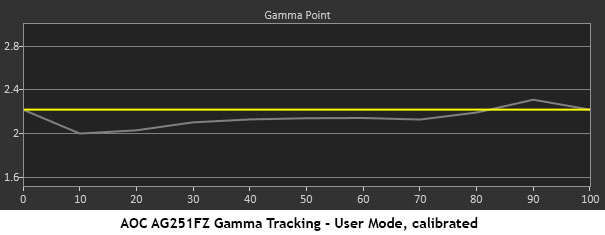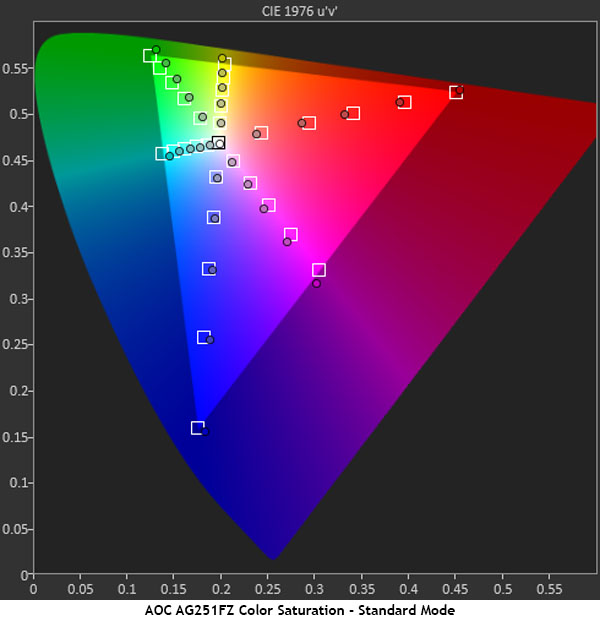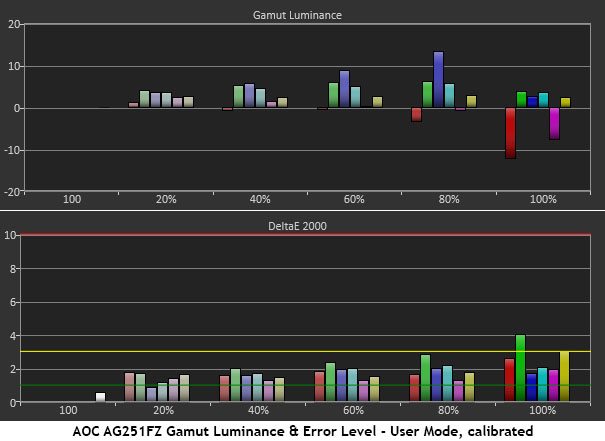AOC AG251FZ 240Hz FreeSync Monitor Review
Why you can trust Tom's Hardware
Grayscale, Gamma & Color
The AG251FZ offers users a couple of viable options for image setup. In the Standard Eco mode, Game Mode off, and color temp set to Warm, you get decent performance that is not begging for a calibration. If you want that last 1%, select User and adjust the RGB sliders as we did. You’ll also need to make a gamma adjustment, which we’ll detail for you.
Grayscale Tracking
Our grayscale and gamma tests are described in detail here.




If you compare the first and fourth charts, you’ll only see a tiny difference. Out of the box, the AG251FZ measures well but shows a slight purple tint at 100% brightness. That alone won’t take it off the “doesn’t need calibration” list. This display is a good performer. Selecting the sRGB color temp preset takes things to a warmer place with a reddish tint across the entire range. If you choose User, you’re committed to a calibration, because left unchanged, the picture becomes too blue. Grayscale isn’t an issue here, our main focus is on gamma, which we’ll talk about momentarily.
Comparisons


Gaming monitors aren’t known for super accurate color, especially in an un-calibrated state. The AG251FZ manages to bypass that notion with an excellent 1.11dE default score. Our adjustments only yielded a tiny gain, so this display easily earns its way onto our “most accurate” list. We can think of a few professional screens that would benefit from this level of quality.
Gamma Response





Gamma tracking is where the AG251FZ has a few issues. After measuring the many possible settings combinations, we concluded that there is no way to achieve ideal tracking at the 2.2 level. The first chart appears to show a need for reduction in the contrast slider. That served to tighten up the grayscale, but gamma was unaffected. Choosing the sRGB preset made most of the middle and brighter tones darker while increasing the darkest steps. The net effect was a reduction in perceived contrast.
In the User mode, our RGB changes had a positive impact when combined with the Gamma 2 preset. Shadow detail is still a little bright, but some gamers might consider that an asset. Most of the luminance values are close enough to the line to be considered visually correct. The last chart shows the Gamma 3 option. It’s clearly too dark, and in a monitor with 1000:1 contrast the image is murky and flat.
Comparisons


The AG251FZ is last. Tracking is simply not as tight as the other screens. The difference is small but can be seen in a side-by-side comparison. The average value test has a better result as the AOC manages to keep its luminance values around the 2.2 mark.
Get Tom's Hardware's best news and in-depth reviews, straight to your inbox.
Color Gamut & Luminance
For details on our color gamut testing and volume calculations, please click here.








Luckily, our less-than-impressive gamma numbers do not impact gamut and luminance accuracy too much. The AG251FZ’s native color points match the sRGB spec very closely. In its default state, the average error is only 2.37dE, which puts it in very good company. The sRGB preset takes that error only a tad higher, to 2.75dE, so that result is a wash. In the User mode, we managed to reduce the number to 1.87dE. The only color that shows any issues is red, which has a few under-saturated targets. Our adjustments mainly served to bring luminance levels to a more neutral state. This makes a visual improvement in color quality.
Comparisons


All the screens operate in a small window of good color accuracy. Only the Dell has any visible errors, and they will be hard to spot unless you’re looking for them. The AG251FZ takes a solid third place in the comparison. Had we left its settings at their defaults, the outcome would have been much the same. The gains are small, but when you pay good money for a display, you should wring every last drop of performance from it. Gamut volume exceeds 97% of the sRGB standard, which is about average for the category. The missing 3% is due to a tiny deficiency in green, which removes a sliver from the left side of the gamut triangle. It won’t affect gameplay in the slightest.
MORE: Best Gaming Monitors
MORE: Best Professional Monitors
MORE: How We Test Monitors
MORE: How To Choose A Monitor
MORE: All Monitor Content
Current page: Grayscale, Gamma & Color
Prev Page Brightness & Contrast Next Page Viewing Angles, Uniformity, Response & Lag
Christian Eberle is a Contributing Editor for Tom's Hardware US. He's a veteran reviewer of A/V equipment, specializing in monitors. Christian began his obsession with tech when he built his first PC in 1991, a 286 running DOS 3.0 at a blazing 12MHz. In 2006, he undertook training from the Imaging Science Foundation in video calibration and testing and thus started a passion for precise imaging that persists to this day. He is also a professional musician with a degree from the New England Conservatory as a classical bassoonist which he used to good effect as a performer with the West Point Army Band from 1987 to 2013. He enjoys watching movies and listening to high-end audio in his custom-built home theater and can be seen riding trails near his home on a race-ready ICE VTX recumbent trike. Christian enjoys the endless summer in Florida where he lives with his wife and Chihuahua and plays with orchestras around the state.
-
Newtoobuilding Would absolutely LOVE this for Quake live or Quake champions!!!!Reply
wonder if 1060 gtx would be anywhere close to supporting it -
alextheblue If you don't see the point in a display like this, you're obviously not in the target audience. I keep seeing comments on TN gaming display reviews that are absolutely ridiculous. This thing is about speed. Why are you reading a review of a 240hz TN gaming display? Go find reviews of different panel tech. That would be like commenting on a review of a professional IPS display, and pissing and moaning about the input lag and the low refresh rate. Do you also comment on reviews of sports cars and whine about the lack of third row seating and the low ground clearance? Simply incredible.Reply
Also, why is Tom's still using a 285 for their Freesync reviews? Even a 580 would help you put the display through it's paces a little bit more. -
mrmez Reply20275445 said:Won't be buying anything until that 4k, 144hz, hdr hits next year...
I'd like to know what graphics card would be running that.
You know, since a 1080ti can barely crack 60fps @ 4k in GTAV. -
MaCk0y Can always use Custom Resolution Utility to increase the freesync range from 48Hz to a lower value. I have mine changed from 48 to 30. Not like it would be a good experience playing at that framerate though at least for an FPS.Reply -
AgentLozen I like the people who dismiss this monitor based on some superficial quality.Reply
"No CI / Common Interface? .. pass."
"Contrast 1000:1 Next!"
"Isn't a 10-bit AMVA panel? Skip."
"It doesn't come in green? Try again."
I like ALEXTHEBLUE's summary:
ALEXTHEBLUE said:If you don't see the point in a display like this, you're obviously not in the target audience...
edit:
This Corvette doesn't seat seven passengers? I don't see the point to this car. Pass.